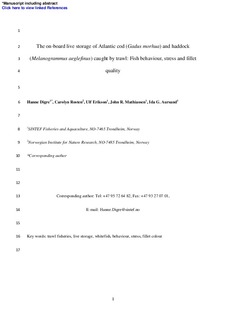| dc.contributor.author | Digre, Hanne | |
| dc.contributor.author | Rosten, Carolyn | |
| dc.contributor.author | Erikson, Ulf Gøran | |
| dc.contributor.author | Mathiassen, John Reidar Bartle | |
| dc.contributor.author | Aursand, Ida Grong | |
| dc.date.accessioned | 2017-10-24T07:15:24Z | |
| dc.date.available | 2017-10-24T07:15:24Z | |
| dc.date.created | 2017-06-18T17:25:53Z | |
| dc.date.issued | 2017 | |
| dc.identifier.citation | Fisheries Research. 2017, 189 42-54. | nb_NO |
| dc.identifier.issn | 0165-7836 | |
| dc.identifier.uri | http://hdl.handle.net/11250/2461568 | |
| dc.description.abstract | The aim of the present study was to assess the effects of the short-term live storage of Atlantic cod and haddock on residual blood in fillets. The fillet colour characteristics of fish sampled after 0, 1.5, 3 and 6 h of live storage were compared with fish subjected to current commercial processing procedures. Fish behaviour during live storage was also assessed, along with handling stress, by measuring the blood constituents (cortisol, glucose, lactate, pH and haematocrit), the initial white muscle pH, muscle twitches and length of time to the onset of rigor. The fillet colour in the CIE L*a*b* colour space was determined on fresh fillets (on-board) and the presence of discolouration was quantified by using a modified version of the Fillet Quality Index method. Fish behaviour analysis performed during live storage showed some signs of stress and that the condition of fish caught at greater depths was inferior to fish caught in shallower waters. The survival rate varied between the different trials (48.9 to 92.5 29 %), and was likely impacted by the fishing depth. The blood chemistry data showed that the captured fish were somewhat stressed, but we were not able to clarify whether the fish were becoming gradually more stressed during the subsequent live storage, or whether the observed increase or lack of recovery were a result of a delayed response for the various stress parameters. The occurrence of blood spots and discolouration was low in fillets cut from both species of fish just after capture. Subsequent live storage did not change this scenario. The colour characteristics of fillets cut from dead fish after 4.5-5.5 h were only marginally inferior to fillets from all the other treatments. | nb_NO |
| dc.language.iso | eng | nb_NO |
| dc.subject | trawl fisheries | nb_NO |
| dc.subject | live storage | nb_NO |
| dc.subject | whitefish | nb_NO |
| dc.subject | behaviour | nb_NO |
| dc.subject | stress | nb_NO |
| dc.subject | fillet colour | nb_NO |
| dc.title | The on-board live storage of Atlantic cod (Gadus morhua) and haddock (Melanogrammus aeglefinus) caught by trawl: Fish behaviour, stress and fillet quality | nb_NO |
| dc.type | Journal article | nb_NO |
| dc.type | Peer reviewed | nb_NO |
| dc.description.version | acceptedVersion | nb_NO |
| dc.source.pagenumber | 42-54 | nb_NO |
| dc.source.volume | 189 | nb_NO |
| dc.source.journal | Fisheries Research | nb_NO |
| dc.identifier.doi | 10.1016/j.fishres.2017.01.004 | |
| dc.identifier.cristin | 1476925 | |
| dc.relation.project | Norges forskningsråd: 199447 | nb_NO |
| cristin.unitcode | 7566,2,0,0 | |
| cristin.unitcode | 7566,5,0,0 | |
| cristin.unitname | Fiskeriteknologi | |
| cristin.unitname | Prosessteknologi | |
| cristin.ispublished | true | |
| cristin.fulltext | postprint | |
| cristin.qualitycode | 1 | |
